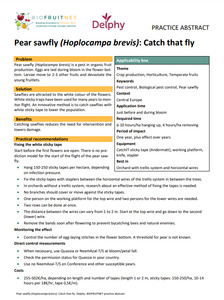{Tool} Pear sawfly (Hoplocampa brevis): Catch that fly (BIOFRUITNET Practice Abstract). Creator(s): Brouwer, Gerjan. Issuing Organisation(s): Delphy. Biofruitnet Practice Abstract, no. 025. (2022)
|
PDF
- Published Version
- English
(Pear sawfly (Hoplocampa brevis): Catch that fly)
439kB | |
|
PDF
- Published Version
- Dutch/Nederlands
(Perenzaagwesp (Hoplocampa brevis): Vang ze weg)
434kB | |
|
PDF
- Published Version
- German/Deutsch
(Birnensägewespe (Hoplocampa brevis): Fangen Sie die Fliege)
441kB | |
![[thumbnail of 2023-06-02 09_00_34-Pear sawfly (Hoplocampa brevis)_ Catch that fly.png]](/44990/7.hassmallThumbnailVersion/2023-06-02%2009_00_34-Pear%20sawfly%20%28Hoplocampa%20brevis%29_%20Catch%20that%20fly.png)  Preview |
Image (PNG)
- Cover Image
- English
107kB |
Document available online at: https://orgprints.org/44990
Summary in the original language of the document
Catching sawflies reduces the need for intervention and lowers damage.
Practical recommendations: 1) Fixing the white sticky tape. Start before the first flowers are open. There is no prediction model for the start of the flight of the pear sawfly. • Hang 150-250 sticky tapes per hectare, depending on infection pressure. • Fix the sticky tapes with staplers between the horizontal wires of the trellis system in between the trees. • In orchards without a trellis system, research about an effective method of fixing the tapes is needed. • No branches should cover or move against the sticky tapes. • One person on the working platform for the top wire and two persons for the lower wires are needed. • Two rows can be done at once. • The distance between the wires can vary from 1 to 2 m. Start at the top wire and go down to the second (lower) wire. • Remove the bands soon after flowering to prevent bycatching bees and natural enemies. 2) Monitoring the effect. • Control the number of egg-laying stitches in the flower bottom. A threshold for pear is not known. 3) Direct control measurements. • When necessary, use Quassia or NeemAzal-T/S at bloom/petal fall. • Check the permission status for Quassia in your country. • Use no NeemAzal-T/S on Conference and other susceptible pears. 4) Costs. • 255-502€/ha, depending on length and number of tapes (length 1 or 2 m, sticky tapes: 150-250/ha, 10-14 hours per 18€/hr, tape 0,5€/m).
| EPrint Type: | Practice tool |
|---|---|
| Teaser: | Learn how to use white sticky tape to reduce the population of sawflies in organic pear production. |
| What problem does the tool address?: | Pear sawfly (Hoplocampa brevis) is a pest in organic fruit production. Eggs are laid during bloom in the flower bottom. Larvae move to 2-3 other fruits and devastate the young fruitlets. |
| What solution does the tool offer?: | Sawflies are attracted to the white colour of the flowers. White sticky traps have been used for many years to monitor flight. An innovative method is to catch sawflies with white sticky tape to lower the population. |
| Country: | Netherlands |
| Type of Practice Tool: | Practice abstracts |
| Keywords: | Pest control, Biological pest control, Pear sawfly |
| Agrovoc keywords: | Language Value URI English pest control http://aims.fao.org/aos/agrovoc/c_5726 English biological pest control http://aims.fao.org/aos/agrovoc/c_330635 English Tenthredinidae http://aims.fao.org/aos/agrovoc/c_29943 |
| Subjects: | Crop husbandry > Production systems > Fruit and berries Crop husbandry > Crop health, quality, protection |
| Research affiliation: | European Union > Horizon 2020 > Biofruitnet Netherlands > Other organizations Netherlands European Union > Organic Farm Knowledge |
| Horizon Europe or H2020 Grant Agreement Number: | 862850 |
| Related Links: | https://organic-farmknowledge.org/tool/44990, https://biofruitnet.eu, https://organic-farmknowledge.org/tool/44937, https://twitter.com/farm_knowledge/status/1664531923564126208, https://www.facebook.com/organicfarmknowledge/posts/pfbid0Yeseiaj4rQwQZTp2oQvFuPvuvXAavjV4KgFwpnAvHC5hyPgD8iWmrkui3mGpraz7l |
| Project ID: | ofk |
| Deposited By: | Basler, Andreas |
| ID Code: | 44990 |
| Deposited On: | 24 Dec 2022 10:10 |
| Last Modified: | 02 May 2024 10:31 |
| Document Language: | English, German/Deutsch, Dutch/Nederlands |
| Status: | Published |
Repository Staff Only: item control page


